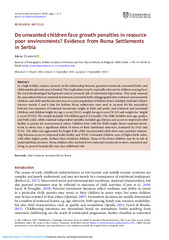Prikaz osnovnih podataka o dokumentu
Do unwanted children face growth penalties in resource poor environments? Evidence from Roma Settlements in Serbia
| dc.creator | Čvorović, Jelena | |
| dc.date.accessioned | 2023-02-04T12:54:08Z | |
| dc.date.available | 2023-02-04T12:54:08Z | |
| dc.date.issued | 2022 | |
| dc.identifier.issn | 1469-7599 (Online) | |
| dc.identifier.uri | https://www.cambridge.org/core/journals/journal-of-biosocial-science/article/do-unwanted-children-face-growth-penalties-in-resource-poor-environments-evidence-from-roma-settlements-in-serbia/9ED157B1C6C54B11D7FA3B1EF18C02DF | |
| dc.identifier.uri | https://dais.sanu.ac.rs/123456789/13869 | |
| dc.description.abstract | In a high fertility context, research on the relationship between parental investment, unwanted births and child nutritional outcomes is limited. The implications may be especially relevant for children coming from the most disadvantaged backgrounds and at increased risk of nutritional deprivation. This study assessed the association between maternal investment, unwanted births disaggregated into mistimed and unwanted children, and child nutritional outcomes in a poor population of Serbian Roma. Multiple Indicator Cluster Surveys rounds 5 and 6 data for Serbian Roma settlements were used to account for the association between two measures of maternal investment: weight at birth and parity, and mistimed and unwanted children, and children height-for-age z-score (HAZ), weight-for-age z score (WAZ) and weight-for- height z-score (WHZ). The sample included 130 children aged 0-24 months. The child variables were age, gender, and birth order, while maternal independent variables included age, literacy and access to improved toilet facility as proxies for socioeconomic status. Children born with low birth weight (lower maternal investment in utero) face a significant deficit in terms of their nutritional outcomes, measured by HAZ and WAZ. The effect was aggravated for height if the child was unwanted while there was a positive relationship between access to improved toilet facility and WHZ. Unwanted children were of higher birth order, with older, higher parity mothers than mistimed children. Many of the Roma children may be at risk of undernutrition, however, Roma children who received lower maternal investment in utero, unwanted and living in poorest households may face additional risk. | sr |
| dc.language.iso | en | sr |
| dc.publisher | Cambridge University Press | sr |
| dc.relation | info:eu-repo/grantAgreement/MESTD/inst-2020/200173/RS// | sr |
| dc.rights | openAccess | sr |
| dc.rights.uri | https://creativecommons.org/licenses/by/4.0/ | |
| dc.source | Journal of Biosocial Science | sr |
| dc.subject | unwanted children | sr |
| dc.subject | height | sr |
| dc.subject | Roma | sr |
| dc.subject | child nutrition | sr |
| dc.title | Do unwanted children face growth penalties in resource poor environments? Evidence from Roma Settlements in Serbia | sr |
| dc.type | article | sr |
| dc.rights.license | BY | sr |
| dc.rights.holder | The Author | sr |
| dc.citation.spage | 1 | |
| dc.citation.epage | 11 | |
| dc.identifier.doi | 10.1017/S0021932022000335 | |
| dc.type.version | publishedVersion | sr |
| dc.identifier.fulltext | http://dais.sanu.ac.rs/bitstream/id/55386/do-unwanted-children-face-growth-penalties-in-resource-poor-environments-evidence-from-roma-settlements-in-serbia.pdf | |
| dc.identifier.rcub | https://hdl.handle.net/21.15107/rcub_dais_13869 |

